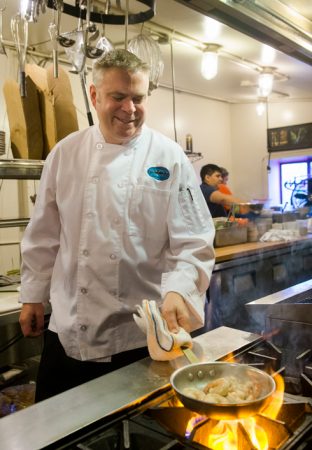Tucked between treats and toys, Anne Mason’s childhood Christmas stocking contained a solitary orange. Growing up in California, this was no ordinary orange from Santa. Mason can still taste it today. It likely came from a local citrus grove. Heavy for its size with skin as vivid as an autumn sunset, the inside held thousands of tiny plump sacs, barely restraining the sweet-scented juice.
An orange presented at its peak is extraordinary. Santa was on to something.
Mason, who owns three Ketchum restaurants along with her husband Scott, said citrus is a key ingredient in all three: Ketchum Grill, Enoteca and Town Square Tavern. Trained in pastries, Mason braces for winter by citrus-izing desserts, ice creams and sorbets. Scott looks to citrus for its acidic properties, which he incorporates into dozens of savory applications, including a surprise tomato chutney gilded with oranges and limes, served alongside the Grill’s legendary meatloaf.
Citrus fruit is the savior from winter’s darkness for chefs. It also happens to be the time of year that citrus—lemons, limes, oranges, grapefruits and more—is in season. Though available year-round, citrus shines like a beacon during the too short days and endlessly long nights of wintertime. Who hasn’t experienced the sad fate of purchasing citrus in the summer only to be met with tired pulp, squeezing a miserly amount of juice from a fruit woefully out of season?
There are more than 1,800 varieties of citrus, although it’s tough to name much more than a dozen. Even more surprising, scientists believe there are only three “true” citrus species and all 1,800-plus varieties sprang from these few ancient plants.

Doug Jensen, executive chef at Sawtooth Brewery Public House, makes citrus grilled shrimp to pair with a blood orange and grapefruit IPA called Myopia. Photo by Dev Khalsa
FAMILY TREES
The three “true” citrus species are native to South and Southeast Asia, dating back more than seven million years ago, although recent genetic research has convinced a subset of scientists that a fourth “true citrus” species exists. All other citrus is a result of hybridization, both natural and artificial, over millions of years. Those original three genetic “trees” include Citrus reticulata (mandarins), C. maxima (pomelos) and C. medica (citrons). The fourth ancient citrus species, C. micrantha, in the papeda group, is believed to be the progenitor of the lime.
That navel orange in Mason’s childhood stocking? It’s a cross between a pomelo and a mandarin orange. What is a pomelo? It is the largest citrus fruit and the original ancestor of the common grapefruit, which itself is a hybrid of a sweet orange in the mandarin family and a pomelo.
Lemons, including the common Eureka variety and the multi-fingered Buddha’s hand, descend from the mandarin and citron family trees, while the common Persian lime you find in grocery stores is a hybrid of the small key lime and a lemon, crossing three citrus geneses.
If it seems there was a superfluity of cross-breeding and inbreeding among citrus, there was, but how much is too much? Without that continuing inter- and intra-crossbreeding, there wouldn’t be recent additions, such as the Cara Cara orange (red-fleshed navel orange discovered in Venezuela in 1976) or the Meyer lemon, a cross between a lemon and a mandarin, first brought to the U.S. from China in 1908 by botanist Frank Meyer.
In addition to the common lemons, limes, grapefruits, and mandarins (which include navel oranges, clementines, tangerines, satsumas, tangelos, blood oranges), Americans have access to an assortment of specialty citrus such as kaffir lime (prized for its fragrant leaves used in Southeast Asian cooking), Japanese yuzu (known for its zest), kumquats, limequats and finger limes. Finger limes are also called “caviar” limes because of the tiny spherical juice vesicles inside the finger-shaped fruits.
CITRUS IN THE KITCHEN
Doug Jensen professed an affinity for blood oranges long ago. He isn’t Italian, but he built his culinary chops on the simplistic foundation of Italian cuisine at an award-winning Italian restaurant in Salt Lake City, later at the now-closed Cornerstone in Ketchum, and currently as executive chef of Sawtooth Brewery Public House. If you think pub food is pedestrian, then you haven’t tried Jensen’s fare.
“Blood oranges are legendary in southern Italy,” he said. Sawtooth Brewery founder and head brewer Paul Holle and Jensen recently collaborated on a blood orange pairing to offer this winter. Holle created a small batch, hazy IPA with blood orange and grapefruit, called Myopia. Jensen created a special dish to pair with the beer: citrus-grilled shrimp with baby kale, pinto beans, blood orange, pistachios and vanilla-mascarpone vinaigrette.
Jensen utilizes other citrus besides his favorite blood orange. “Whether it’s lemon or lime juice,” he said, “it’s an acid that brings out a different flavor note than vinegar does. It just gives dishes a freshness that you don’t get with a splash of vinegar.”

Anne Mason developed a lemon pudding cake, served at Town Square Tavern in Ketchum, that guests clamor for. Photo by Dev Khalsa
Aiolis—made-from-scratch mayonnaise-type sauces—at Sawtooth always feature citrus juice and zest. Don’t forget the zest, the outer skin of citrus covering the white, bitter pith. Zest is full of essential oils that carry the flavor of the flesh, but in concentrated form.
“I love lemon zest for a coating on fish,” Scott Mason said. “It also brightens flavor, like the juice, and adds lemon flavor. When you really don’t want more moisture in the dish, you can use zest to add flavor without extra liquid.”
The Masons use lemon zest in gremolata, tossing it with bread crumbs and herbs. Jensen sometimes swaps out the lemon zest with orange zest, pairing the orange gremolata with braised lamb shanks or osso buco.
The pan-seared trout dish at the Mason’s Enoteca restaurant is coated in a mixture of lemon zest, bread crumbs and Parmesan cheese. “The cheese creates umami [flavor], the bread crumbs give it a crunchy crust and the lemon zest brings out something different,” he said. That something is vibrancy, bright enough to chase away winter blues.
Ann Mason developed a lemon pudding cake, served at Town Square Tavern, that guests clamor for. “It’s sort of a magical cake,” she said. Served in individual ramekin dishes, the technique of folding whipped egg whites into a yolk-based batter turns the cake into two layers in the oven: a bottom layer that is lemon-curd-like and a fluffy top layer. She also makes key lime pie with a graham cracker crust, although she uses regular limes, not key limes, because the latter are difficult to get and do not yield as much juice as Persian limes. Another lime-centric dessert is coconut lime sorbet, a dessert requested by Allen & Company, the high-profile conference that takes place at Sun Valley Resort each July, attracting major tech and media moguls. Mason’s sorbet is made with coconut milk and lime juice. “It’s dairy-free and vegan, too.” Scott added.
Town Square Tavern also takes advantage of grapefruits being available year-round for its perennial smoked trout and baby kale salad, but, Scott said, “Even though you can get it all year, it really shines in the winter when it’s at its peak. It’s plumper, juicier and just better all-around in the winter.”
That is really the point. Using ingredients in season, at their peak, makes for better flavored food, and citrus is no different. Citrus in season delivers an additional
benefit: a bright splash of flavor on a cold winter’s day.

Broiled Pink Grapefruit with Citrus Honey and Toasted Coconut
Adapted from “The Great Ranch Cookbook”
by Gwen Ashley Walters
This is such an easy breakfast or brunch treat. You can use any pink grapefruit, but Rio Star from Texas is a deep pink with a sweet-tart spritzy flavor.
You will needs:
4 pink grapefruits
3/4 cup honey
Juice and zest of 1 lemon
1 cup shredded unsweetened coconut
Heat the oven to broil and place a rack about 8 inches from the top heating element. Slice grapefruits in half crosswise. Run a small, sharp knife around the outside of the fruit and through the sections for easier eating and to create pockets for the honey to melt into. Place grapefruit halves on a baking sheet, cut-side up. Whisk honey with lemon juice and zest. Drizzle grapefruits with about 2 tablespoons of honey each and top with 2 tablespoons of coconut. Broil until warm and coconut is golden brown, being careful not to burn coconut, about 5 minutes. Keep a close eye on the coconut. Once it starts to brown, it goes quickly.
Makes 8 Servings


